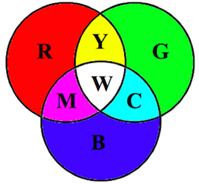 Many students of physics have seen a diagram similar to the one shown at the right. The diagram depicts three circles colored with the primary colors of light - red, green and blue. The primary colored circles overlap to produce other colors of light, known as the secondary colors of light: cyan (C), magenta (M) and yellow (Y). These three colors - C, M, Y - are also the three primary colors of paint. The colors of light that they absorb are those directly opposite them on the color wheel. Cyan pigment absorbs red light. Magenta pigment absorbs green light. And yellow pigment absorbs blue light.
|